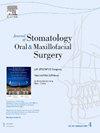上颌-下颌骨畸形患者因长脸畸形引起的特殊姿势调整。
IF 1.8
3区 医学
Q2 DENTISTRY, ORAL SURGERY & MEDICINE
Journal of Stomatology Oral and Maxillofacial Surgery
Pub Date : 2024-12-18
DOI:10.1016/j.jormas.2024.102200
引用次数: 0
摘要
背景:在表现出上颌-下颌畸形(MMD)的患者中,怀疑存在特定的病理性姿势适应;然而,没有一项研究报告了面部尺寸和姿势之间的相关性。在这项研究中,我们假设病理性姿势适应与烟雾病患者的长脸畸形和随后的口腔呼吸有关。通过直立骨骼的双平面x线(EOS成像®)分析呼吸模式、体位对齐和头位测量,然后进行三维重建。结果:烟雾病患者表现为颈椎下段后凸过度(C3-C7角:10.6°[3.9;17.5] vs. 3.2°[-6.4;7.6], p < 0.01),头部前倾(OD-C7角度:10.5°[8.5;15.1°vs. 6.2°[3.0;8.4], p < 0.01),与对照组相比,后矢状面平衡(矢状面垂直轴:-15.7 mm [-25.9;-5.2] vs. -1.4 mm [-17.8;7.0], p = 0.014)。颈椎后凸过度、前向头部姿势和后向矢状平衡与法兰克福-下颌平面角(用于评估面部长度的头侧测量变量)的较高值相关。在烟雾病患者中,口腔呼吸与FMA角相关。结论:烟雾病与特定病理性体位适应有关,体位适应与长脸畸形和口腔呼吸有关。我们的研究结果表明,姿势的改变源于上呼吸道。本文章由计算机程序翻译,如有差异,请以英文原文为准。
Specific postural alignment alterations due to long-face deformity in patients with maxillo-mandibular deformities
Background
A specific pathological postural adaptation is suspected in patients exhibiting maxillo-mandibular deformity (MMD); however, none study reported a correlation between facial dimensions and posture.
In this study, we hypothesized that pathological postural adaptations are related to long-face deformity and subsequent oral breathing in patients with MMD
Methods
Thirty patients with MMD and 20 healthy subjects. Breathing mode, postural alignment and cephalometry were analyzed through a biplanar X-ray (EOS imaging®) of the skeleton in an upright position, followed by three-dimensional reconstruction.
Results
Patients with MMD exhibited hyperkyphosis of the lower region of the cervical spine (C3-C7 angle: 10.6° [3.9; 17.5] vs. 3.2° [-6.4; 7.6], p < 0.01), forward head posture (OD-C7 angle: 10.5° [8.5; 15.1] vs. 6.2° [3.0; 8.4], p < 0.01), and backward sagittal balance compared with controls (sagittal vertical axis:15.7 mm [-25.9; -5.2] vs. -1.4 mm [-17.8; 7.0], p = 0.014). Cervical hyperkyphosis, the forward head posture, and the backward sagittal balance were related to higher values of the Frankfort-mandibular plane angle (a cephalometric variable used to assess face length). In patient with MMD, oral breathing was correlated to the FMA angle.
Conclusion
MMD is associated with a specific pathological postural adaptation which is correlated with Long-face deformity and oral breathing. Our results suggest that the altered posture originates from the upper airways.
求助全文
通过发布文献求助,成功后即可免费获取论文全文。
去求助
来源期刊

Journal of Stomatology Oral and Maxillofacial Surgery
Surgery, Dentistry, Oral Surgery and Medicine, Otorhinolaryngology and Facial Plastic Surgery
CiteScore
2.30
自引率
9.10%
发文量
0
审稿时长
23 days
 求助内容:
求助内容: 应助结果提醒方式:
应助结果提醒方式:


